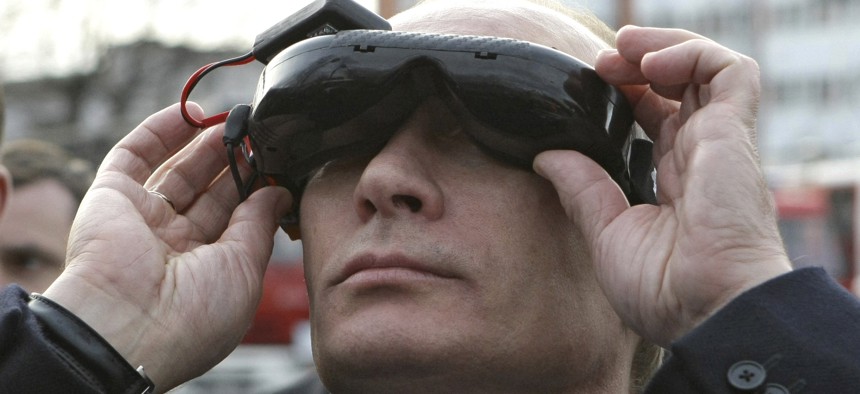
Russian Prime Minister Vladimir Putin tests goggles with an electronic connection that allows him to see the view from an unmanned drone aircraft, during an exhibition of equipment displayed at Russia's Civil Defense Academy in Moscow's Khimki surburbs. AP / ALEXI NIKOLSKY
US Army Racing to Catch Up to Russia On Battle Drones
After watching UAVs dominate eastern Ukrainian skies, the service is seeking counter-drone tech and new families of flying robots.
On the battlefields of eastern Ukraine, Russian-backed infantry and artillery units have used more than 16 types of drones to identify enemy positions and deliver fire, often within minutes. That’s given Lt. Gen. H.R. McMaster, the decorated tank commander who runs the U.S. Army’s Capabilities Integration Center cause for concern.
“Russia has established air supremacy over Ukraine from the ground” and in the process, exposed a gap in his own Army’s ability to deal with drones, McMaster told reporters on September 28th.
But his service, which recently wrapped up a prolonged examination of Russian tactics, isn’t sitting still. A little more than a year ago, the Army began what they call the Maneuver Fires Integration Experiment at Fort Sill in Oklahoma to speed next-generation anti-drone technology to soldiers.
“What we found is we can use existing capabilities in a different way,” said McMaster. To counter “low, slow, small” drones, the Army is eyeing software-programmable radar, directed energy, and next-generation electronic warfare gear — and “putting it on vehicles we already have and integrating it organizations that already exist.”
In October, troops continued to refine the strategy at the Army Warfighting Assessment wargame at Fort Bliss.
Now, they will be fielding counter UAS technologies “very quickly,” says McMaster.
The Army will also soon publish its comprehensive Counter UAS Strategy, spelling out what they’ve learned and what they intend to do.
But beating enemy drones is only the first part of a larger plan to win on tomorrow’s battlefield. The Army wants to press the attack with its own small drones.
“This is a big area of focus. We’re looking at a whole family of unmanned systems from the very low squad level. What I’ve talked about as a priority is the squad at a foundational level,” said McMaster. “We need a number of platforms that we can deploy. We’re interested in vertical-takeoff-and-push capability” as well as drones that can fly autonomously, resist complex electromagnetic attacks. The Army wants drones “that can be deployed from a vehicle and hover over a vehicle. We’re experimenting with all of these capabilities,” he said.
Bits and pieces of that family are visible in several recent endeavors and experiments, such as the 18-gram PD-100 Black Hornet from Prox Dynamics, an autonomous tactical drone that the military is rushing out to special operations units and Marines.
The most recent budget request for the Rapid Innovation Fund seeks a “mission enhanced system based on collective UAS input,” The system should have an open architecture, be modular, and be able to handle “disparate-data-fused intelligence, surveillance, and reconnaissance (ISR),” data in an environment where “degraded position, navigation and timing (PNT), communications (dissemination of situation awareness information), and electronic warfare” effects are present.
That sounds fancy, but, decades ahead, will look quaint, according an unfinished draft of the U.S. Army Robotic and Autonomous Systems Strategy provided to reporters. The document describes how the Army will use drones in the near term (2016-20) the mid-term (2020-30), and the far term (2030-40).
In the near term, handheld drones like the Black Hornet would provide intelligence to dismounted troops. After 2020, that intelligence mission would switch to small swarms, according to the draft strategy document. “To increase situational awareness, the Army delivers swarms of multiple small robots to an area of operations in advance of close combat maneuver forces,” it says. “Delivery options range from using a simple shipping container to a special-purpose platform from which smaller craft or robotic systems are launched or maintained. Swarm robots will be fully powered, self-unpacking, and ready for immediate service.”
One vignette pictures squads and platoons in the year 2025 “equipped with small RAS in urban terrain make[ing] contact on their own terms, thus reducing the need for formations to maintain the traditional 6:1 attacker-to-defender ratio commonly associated with conventional urban combat operations.” Meanwhile, “UAS sensors loitering overhead work with UGS platforms on the ground to provide enhanced situational awareness to human teammates in order to create better tactical options for small unit leaders.”
On the 2030 battlescape, soldiers will command drones and receive their data via a linked-up “warrior suit” worthy of Tony Stark. The suit will feature “integrated displays that aggregate a common operating picture, provides intelligence updates, and integrates indirect and direct fire weapons systems.” Read that to mean firing for effect from your face.
The draft document also depicts armed ground units that become increasingly autonomous as 2030 approaches. It doesn’t mention arming them, but does feature pictures of “unmanned combat vehicles with advanced payloads” with large guns. Conflicting reports suggest Russia may have already fielded armed ground robots in Syria, or at least might be claiming to.
McMaster says he would consider arming future drones that work alongside soldiers, a big difference from the drones that the military uses today for precision strikes, or even the small reconnaissance drones currently flying over Ukraine.
“I do see an opportunity to arm,” said McMaster. “It’s one of the reasons we need an open architecture.”




